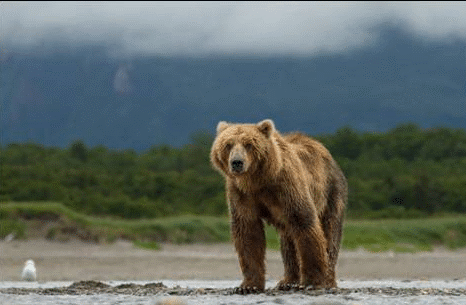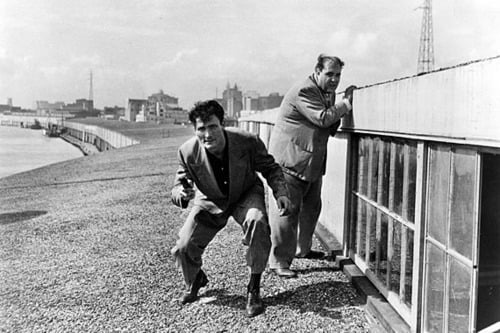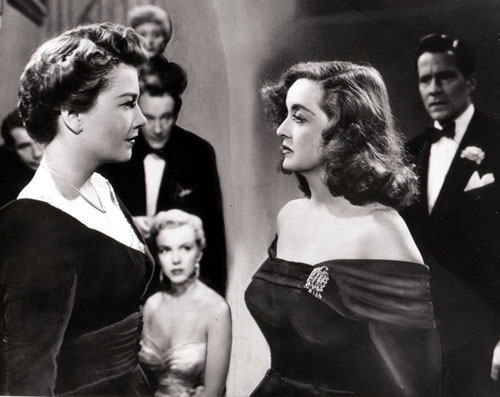Written by Alastair Fothergill and Adam Chapman
Directed by Alastair Fothergill and Keith Scholey
UK and USA, 2013
During its fledgling years as a film studio, the Walt Disney Company helped revolutionize the nature documentary with its True-Life Adventure series. Here, as never before, audiences could thrill to the story of seals, beavers, bears, tigers, and the rest of the creatures sharing space with us on Earth. These days, what is most striking about these early documentaries is less the physical ground they cover, and more that they come from a patient time in filmmaking. Documentaries like The Living Desert and Seal Island featured narration and music, and sometimes attempted to play up the humor of an animalistic situation, but they were still created by people who afforded their presumed audience a base level of intelligence. In some respects, these nature documentaries were born out of the insistence on realism in one of Disney’s earliest and greatest animated features, Bambi.
If there is anything positive to say about Disney’s latest nature documentary that wishes it didn’t have to be a documentary, Bears, it’s that this new film allows us to appreciate Bambi even more. That 1942 feature, with lush and verdant visuals and a stark, austere story with minimal dialogue or character development, is one of Disney’s finest achievements in part because the animators and Disney himself didn’t feel the urge to dumb down the final product to their audience. Such, sadly, is the case with Bears, a movie that gets in its own way from the opening shots. At best, this kid-friendly documentary can inspire questions that relate to the form of nonfiction filmmaking, but inspiring discussion isn’t enough to make Bears a successful piece of work. Directed by Alastair Fothergill and Keith Scholey (and co-directed by Adam Chapman, who co-wrote the picture with Fothergill), Bears is very much of a piece with the rest of the films from Disney’s nature-based offshoot, Disneynature. Disneynature’s first entry, Earth, was essentially a condensed version of the groundbreaking BBC documentary series Planet Earth, making its 13-episode storyline more accessible on the big screen. (Since Fothergill was the executive producer of Planet Earth and directed Earth, the connection to his work with Disneynature is even more inescapable.)
But as the years have gone by, it’s become clear that Disneynature has taken its cue less from the resounding success of recent BBC Natural History documentaries like Life and Human Planet, and more from the equally successful film March of the Penguins. Bears tells a story of a mother bear, Sky, and her two cubs, Scout and Amber, as she leads them across the Alaskan peninsula during their first year of life. There’s peril in the form of two ferocious male bears who are hungry enough to eat their own, when necessary; a thieving wolf who’s willing to lure the cubs to their doom; and a dwindling food supply of salmon who never stay in the same place for very long. Unsurprisingly, Bears looks gorgeous on the big screen; Fothergill, Scholey, and Chapman don’t rely too heavily on tricks of the trade, but there are still a few moments of time-lapse photography, extreme close-ups, slow motion, and so on. In general, the environment that Sky, Scout, and Amber occupy is beautiful enough without an excess of stylistic flourishes.
The issue, unfortunately, has nothing to do with the visuals, but with the aural aspect of Bears, all the way from the very concept that the film “tells” a story. John C. Reilly narrates Bears (it will always be a missed—and now timely—opportunity that Disneynature didn’t cast Stephen Colbert instead) and almost instantly chooses to identify these nameless creatures with made-up monikers. From this moment, it’s difficult not to wonder how much of Bears was created in the editing room; some of the best documentaries, nature or otherwise, do not need to force a story upon those people or creatures who occupy the space. Bears desperately wants there to be a story to tell, so it creates false tension throughout its various episodes. (Bambi had a surfeit of daring in killing off the main character’s mother as a massive inciting incident; do not expect such guts from this film.) The general conflict throughout remains the same—can Sky help her cubs survive their first year, unlike so many who die at such a young age?—but within that, we are given more specific problems that aren’t very well described. For example, when we are introduced to the first of two vicious male bears, Magnus, it’s established that he’s basically the king of the bears in the region. Any who attempt to thwart him are soon defeated, and Reilly explains that Sky needs to keep Scout and Amber far away. Later, we meet Chinook, the other male bear, defined as an outcast who resorts to eating his own kind. But then, later still, we learn, or are told, that Magnus would also eat young bears. As such, that leads to the obvious question: why is one an outcast for eating bears, but not the other? Bears, obsessed solely with surface-level pleasures, doesn’t ever stoop to answer.
 As with Disneynature’s last film, Chimpanzee, the major weakness here is the narration. (Granted, John C. Reilly’s work here is more tolerable than that of Tim Allen in Chimpanzee.) Half of Reilly’s dialogue, at best, is straightforward and informational; although it rarely delves into detailed specifics of the daily lives of these bears, it at least explains the—pardon the pun—bare necessities. The other half is filled with mostly unnecessary and flaccid attempts at humor. At various times, Reilly pretends that he’s one of the cubs or a male bear struggling to grab salmon from the cold waters; at other points, he slips into the first person, as if he’s standing right offscreen mugging for the camera. As such, Bears feels partly like the experience of watching a YouTube cute-animal video and having your uncle—the one who thinks he’s hilarious, even though no one else has the heart to tell him he’s not—make bargain-basement Mystery Science Theater 3000-esque comments by your side.
As with Disneynature’s last film, Chimpanzee, the major weakness here is the narration. (Granted, John C. Reilly’s work here is more tolerable than that of Tim Allen in Chimpanzee.) Half of Reilly’s dialogue, at best, is straightforward and informational; although it rarely delves into detailed specifics of the daily lives of these bears, it at least explains the—pardon the pun—bare necessities. The other half is filled with mostly unnecessary and flaccid attempts at humor. At various times, Reilly pretends that he’s one of the cubs or a male bear struggling to grab salmon from the cold waters; at other points, he slips into the first person, as if he’s standing right offscreen mugging for the camera. As such, Bears feels partly like the experience of watching a YouTube cute-animal video and having your uncle—the one who thinks he’s hilarious, even though no one else has the heart to tell him he’s not—make bargain-basement Mystery Science Theater 3000-esque comments by your side.
It’s admirable that the Walt Disney Company has revived its dedication to documenting the natural world over the past few years. The last 10 years have seen a general boost in interest in nature documentaries on a wider scale, thanks in no small part to Planet Earth; it is this series that Disneynature needs to take inspiration from in its future productions, like next year’s Monkey Kingdom. Bears suffers because it was made by people who presume that they can only keep an audience awake and compelled via schmaltzy music (George Fenton’s score is, at times, obnoxiously overbearing) and painfully cheesy jokes. Planet Earth covers the known world in 13 hours, and manages to show brief stories of the creatures occupying our planet without forcing anything upon them. We do not need to know names, we do not need to be presented with fake crises that lead nowhere. What the makers of Bears needed to presume was that the visuals were enough. The images here are beautiful, but the people who delivered those images don’t trust us to get the message.
— Josh Spiegel







